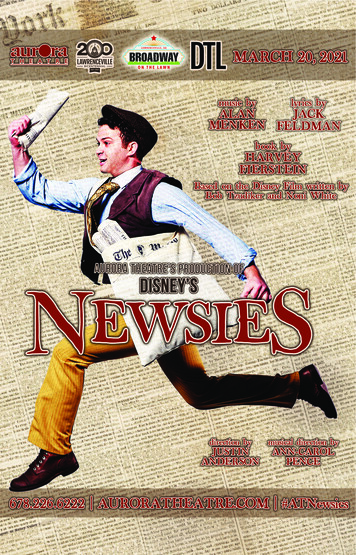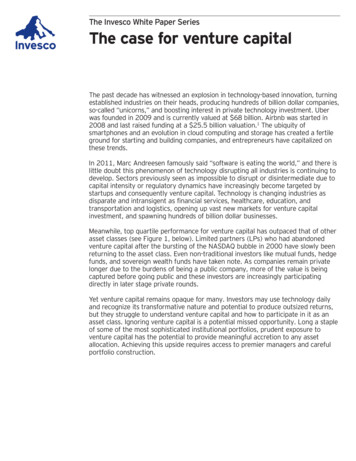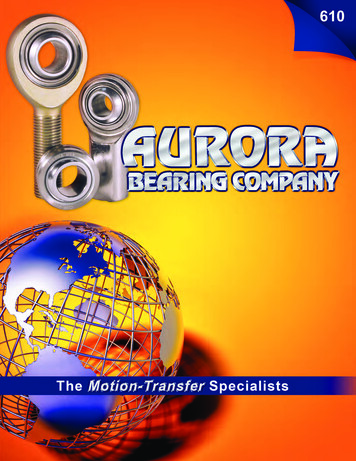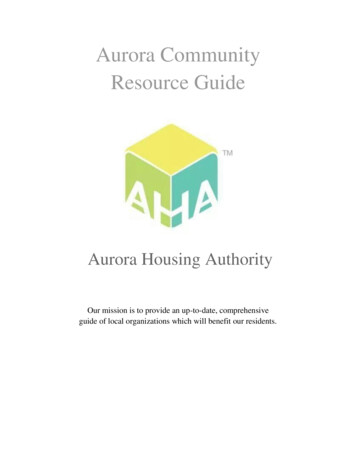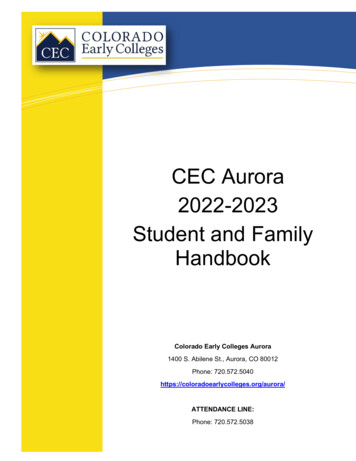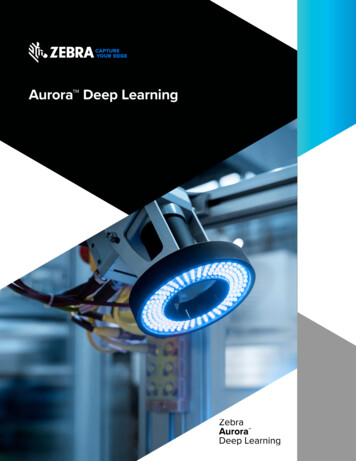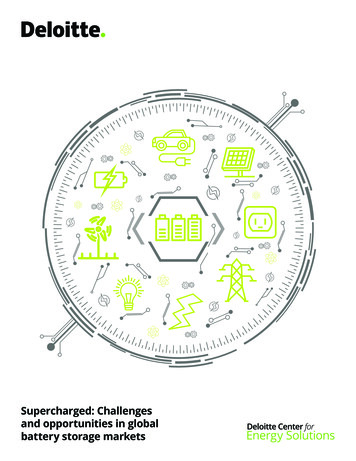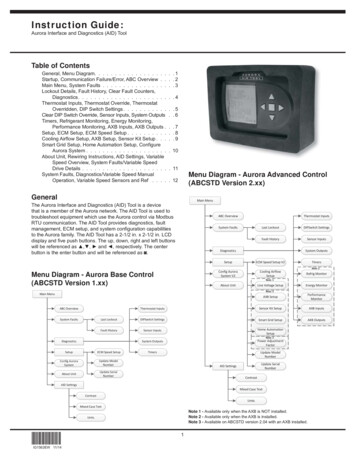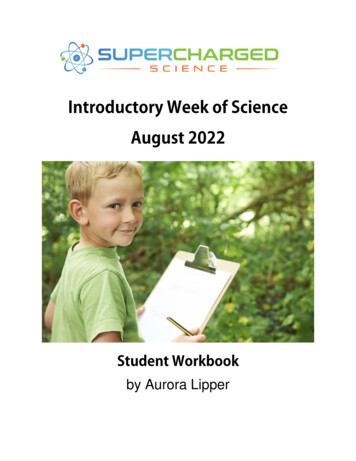
Transcription
by Aurora Lipper
Supercharged ScienceTable of ContentsWelcome to our Week of Science Together! . 3Introductory Week Special Schedule . 5Day 1 Physics: Forces, Mechanics and Building Structures . 6Day 2 Biology/Life Science: Microorganisms & DNA . 7Day 3 Chemistry: Acids/Bases, Reactions, Phase Shifts & Energy . 8Day 3 Chemistry: Acids/Bases, Reactions, Phase Shifts & Energy . 9Day 4 Earth Science: Rocks, Minerals, Crystals and Meteorites . 10Day 5 Engineering: Flying Machines, Rockets, Propulsion and Flight . 12Answers . 13Teaching Science Right. 14 Supercharged Sciencewww.SuperchargedScience.comPage 2
Supercharged ScienceWelcome to our Week of Science Together!I am so excited you’re joining us this week! In this workbook, you’ll find everything youneed to do hands-on real science together.What age is this Science Week for? All ages. If you’ve got a kid interested in science,you’re in the right place. My classes are based on interest and ability more than gradelevel. I suggest trying it out, and if your child is enjoying learning with my classes, thenkeep it up!How long are the classes? Each day, I am doing a live science class for 20-30 minuteswith time for Q&A at the end. Students will then do their experiments after our livesession is over for as long as they need to, typically another 30 minutes or longer. Linksto connect to class are sent in a separate email. (If you don’t have it, please check yourjunk/spam folders.)What do I need to participate? You’ll need the information in this workbook and a smallbox of easy-to-get materials (the list is included in this workbook). You’ll also need toparticipate each day to be able to do the day’s learning activities and projects with us.These sessions are only available live (unless you’ve opted to access them afterwards). Supercharged Sciencewww.SuperchargedScience.comPage 3
Supercharged ScienceWhat will my child learn? By the end of the week, your kids will be happily engaged andexcited, build and inventing every day, long after class is over. The topics we will coverare Physics, Chemistry, Biology, Earth Science, and Engineering. Your child will have animpressive stash of scientific concepts under their belt by the end of the week, as wewill have covered more science than most kids do in a month.How is this different from other programs? In a typical science classroom, there’s a lotof lecturing, note-taking, and solving homework problems. While this certainly has itsplace in learning science, it’s not the first step. Learning science isn’t just a matter ofmemorizing facts and theories. You can't learn science by playing "educational" videogames with watered-down factoids students are supposed to answer.Science is about developing a deep curiosity about the world around us, AND having aset of tools that let kids explore that curiosity to answer their questions. Science is allabout formulating questions, and creating experiments to answer those questions. It's away of thinking, a process of learning that has a definite method. You can't learn thatfrom just reading a textbook, filling out endless rounds of drill worksheets, or watchingsilly cartoon animations.Science education is a three-step process (and I mean teaching science in a way thatyour kids will really understand and remember). Here are the steps:1. Get kids genuinely interested and excited about a topic.2. Give them hands-on activities and experiments to make the topic meaningful.3. Teach the supporting academics and theory.Most science books and curriculum just focus on the third step and may throw in someexperiments as an afterthought. This just isn’t how kids learn.There is a better way. When you provide your kids with these three keys (in order), youcan give your kids the kind of science education that not only excites them, but thatthey remember for many years to come. That’s what we’re going to do with our timetogether this week.Are you READY? Then turn the page and let’s get started! Supercharged Sciencewww.SuperchargedScience.comPage 4
Supercharged ScienceIntroductory Week Special ScheduleI am teaching live classes EVERY DAY for FIVE DAYS for students of all ages! Each daybuilds on the next, so it’s important to participate in all five days. Here’s the schedule: Day 1 Physics: Forces, Mechanics and Building StructuresDay 2 Biology/Life Science: Molecules, Microorganisms and PhotosynthesisDay 3 Chemistry: Acids/Bases, Chemical Reactions, Phase Shifts and EnergyDay 4 Earth Science: Rocks, Minerals, Crystals and MeteoritesDay 5 Engineering: Flying Machines, Rockets, Propulsion and FlightTo connect to class each day, please check your welcome email for all the details.Classes are EVERYDAY ALL WEEK LONG. All classes include time for Q&A after.Materials List:Day 1: PhysicsDay 4: Earth Science Popsicle sticks (one box)String or rope (6 feet)Bucket (1 - 5 gallon)Hot glue gun (low temperature)Day 2: Biology/Life Science Dish soap (1 tsp)Salt (1 tsp)Fruit that is easily squishedPlastic bag that can seal closedRubbing alcohol (keep it COLD)Handheld magnifying lenses (1 or 2)Day 3: Chemistry Red Cabbage (contains anthocyanin)Distilled vinegar (acetic acid)Baking soda (sodium bicarbonate)Epsom salts (and access to the oven)Cups to mix up experiments inPopsicle sticks for stirring/mixingTeaspoons or disposable pipettes or straws Supercharged ScienceMagnetPaper and pencilNail (the kind made of steel)Rocks (6-10 different ones 1-3” long)Distilled vinegarClean, empty glass jarCoffee mug (NOT your favorite one)Day 5: Engineering Masking tapeStraws (paper or plastic)Bouncy ballSkewer or stickOPTIONAL: Paperclips (large, 1)Rubber bands (2)Pliers (for bending the paperclip, needlenosed works best)Red laser pointer (cheap keychain laserswork great)www.SuperchargedScience.comPage 5
Supercharged ScienceDay 1 Physics: Forces, Mechanics and Building Structures1. Tension is when things.2.is when things gettogether.Design Challenge #1:Trial #Load (kg? lb?)Design (Sketch or Describe)1234What did you find? Supercharged Sciencewww.SuperchargedScience.comPage 6
Supercharged ScienceDay 2 Biology/Life Science: Microorganisms & DNA1. Science is all about asking and designingto figure out the answers.2. A is the smallest unit of life that canreplicate independently.Use a microscope or magnifying lenses and find 4-6 specimens. Drawand label each image below (make sure your drawing has all fourparts: boundary, what it is, magnification, and sketch). Refer toexample (image right). Supercharged Sciencewww.SuperchargedScience.comPage 7
Supercharged ScienceDay 3 Chemistry: Acids/Bases, Reactions, Phase Shifts & Energy1. Chemistry is the study of how matter.2. pH (power of Hydrogen) is a measure of howa substance is.Experiment:1. Solution #1 pH2. Solution #2 pHTrial Solution#1Solution2Endothermicor Exothermic?TemperatureShift# tsp/drops# tsp/drops(Cool or Warm?)(Cold/Room/Hot)pH shift(old pH new pH)1234How does temperature affect acidity levels? Supercharged Sciencewww.SuperchargedScience.comPage 8
Supercharged ScienceDay 3 Chemistry: Acids/Bases, Reactions, Phase Shifts & EnergyExperiment:Trial #DescriptionpH(What did you test? Lemonjuice, soda ?)(What color is it?)TemperatureShiftpH shift(old pH new pH)(Did you make itCold/Room/Hot?)12345678910 Supercharged Sciencewww.SuperchargedScience.comPage 9
Supercharged ScienceDay 4 Earth Science: Rocks, Minerals, Crystals and Meteorites1. Minerals arechemical substances.2. Rocks are made of two or more3. Aare arranged inside.is a mineral that looks how theDensity is a measure of how heavy something is for its size. You can find the density of arock by weighing it on a scale (in grams), and then dividing by its volume.Density is mass divided by volume.Volume is how much 3D space it takes up.But how do you find volume? Well, if you took geometryclass, you might know the math equations for perfectshapes, like a sphere, a cube, a cone or a cylinder. But thisrock doesn’t look like any of those! What do you do withsomething that is this shape? It’s such an odd shape ANDit’s full of holes!Here’s how you do it So you first place enough water in a cup that has marks on it for measuring.Make sure you have enough water to cover the entire rock when you stick it in!Note how high the water level is now.Place the rock in the measuring cup and read the newlevel of the water. Subtract the higher number from the lower number, andyou have the volume of the rock! Easy!Water has a density of 1, so anything less than 1 will float.Anything more than 1 sinks! Supercharged Sciencewww.SuperchargedScience.comPage 10
Supercharged Science Supercharged Sciencewww.SuperchargedScience.comPage 11
Supercharged ScienceDay 5 Engineering: Flying Machines, Rockets, Propulsion and Flight1. Rocket engines areengines.2. For every action, there is an equal and oppositeor forces come inTrial#Bouncy Ball(type & size),.Drop Height(feet? meters?)Time Aloft(seconds)123456What did you find? Supercharged Sciencewww.SuperchargedScience.comPage 12
Supercharged ScienceAnswersDay 1:1. Tension is when things get pulled apart.2. Compression is when things get squashed together.Day 2:1. Science is all about asking questions and designing experiments to figure out theanswers.2. A cell is the smallest unit of life that can replicate independently.Day 3:1. Chemistry is the study of how matter interacts.2. pH (power of Hydrogen) is a measure of how acidic a substance is.Day 4:1. Minerals are pure chemical substances. Rocks are made of two or more minerals.2. A crystal is a mineral that looks how the atoms are arranged inside.Day 5:1. Rocket engines are reaction engines.2. For every action, there is an equal and opposite reaction, or forces come in pairs.HINT: Did you notice on Day 5 how difficult it might be to figure out which bouncy balland drop height was the best? That’s because the data table for the experiment wastesting more than one variable at a time!In science experiments, it’s important to only change ONE THING when running yourtests. The secret to making Day 5’s data table work is to only change one of them –either the “Bouncy Ball Type” or the “Drop Height” on one table, not both.If I were doing this myself, I would run my first set of trials for different bouncy balls alldropped from the same height. Then I would figure out which went the highest, andtake that ball and now drop it from different heights to find the perfect drop height. Supercharged Sciencewww.SuperchargedScience.comPage 13
Supercharged ScienceTeaching Science RightHomeschool science isn’t always easy. There’s a lot more to it than most traditional sciencebooks and programs accomplish. If your kid doesn’t remember the science they learned lastyear, you have a problem.What do kids really need to know when it comes to science?Kids who have a solid science and technology background are better equipped to go to college,and will have many more choices once they get out into the real world.Learning science isn’t just a matter of memorizing facts and theories. On the contrary, it’sdeveloping a deep curiosity about the world around us, AND having a set of tools that lets kidsexplore that curiosity to answer their questions.Teaching science in this kind of way isn't just a matter of putting together a textbook with a fewscience experiments and kits.Science education is a three-step process (and I mean teaching science in a way that your kidswill really understand and remember).Here are the steps:1. Get kids genuinely interested and excited about a topic.2. Give them hands-on activities and experiments to make the topic meaningful.3. Teach the supporting academics and theory.Most science books and programs just focus on the third step and may throw in someexperiments as an afterthought. This just isn’t how kids learn.There is a better way. When you provide your kids with these three keys (in order), you cangive your kids the kind of science education that not only excites them, but that they rememberfor many years to come.Don’t let this happen to you. you buy science books that were never really used and now yourkids are filling out college applications and realizing they’re missing a piece of their education—a REALLY big piece. Now that's a setback. Supercharged Sciencewww.SuperchargedScience.comPage 14
Supercharged ScienceSo what do you do?First, don’t worry. It’s not something that takes years and years to do. In fact, I am actuallygoing to do a lot of the heavy lifting when it comes to science education for your student.Here’s how we’re going to do it:Step one: Get kids genuinely interested and excited about a topic.Start by deciding what topic you want your kids to learn. Then, you’re going to get them reallyinterested in it.For example, suppose I want my 10-year old son to learn about aerodynamics. I’ll arrange forhim to go up in a small plane with a friend who is a pilot. This is the kind of experience that willreally excite him.Step two: Give them hands-on activities and experiments to make the topic meaningful.This is where I take that excitement and let him explore it. I have him ask my friend for otherchances to go flying. I’ll also have my friend show him how he plans for a flight. My son willlearn about navigation, figuring out how much fuel is needed for the flight, how the weight theplane carries affects the aerodynamics of it, and so much more.I’ll use pilot training videos to help us figure this out (short of a live demo, video is incrediblypowerful for learning).My son is incredibly excited at this point about anything that has to do with airplanes andflying. He’s sure he wants to be a pilot someday and is already wanting flying lessons (he’s only10 now).Step three: Teach the supporting academics and theory.Now it’s time to introduce academics. Honestly, I have my pick of so many topics, becauseflying includes so many different fields. I mean he’s using angles and math in flight planning,mechanics and energy in how the engine works, electricity in all the equipment on board theplane, and of course, aerodynamics in keeping the plane in the air (to name just a few).I’m going to use this as the foundation to teach the academic side of all the topics that areappropriate.We start with aerodynamics. He learns about lift and drag, makes his own balsa-wood glidersand experiments by changing different parts. He calculates how big the wings need to be to Supercharged Sciencewww.SuperchargedScience.comPage 15
Supercharged Sciencecarry more weight and then tries his model with bigger wings. (By the way, I got a video onmodel planes so I could understand this well enough to work with him on it).Then we move on to the geometry used in navigation. Instead of drawing angles on a blanksheet of paper, our workspace is made of airplane maps.We’re actually planning part of the next flight my son and my pilot buddy will take. Suddenlyangles are a lot more interesting. In fact, it turns out that we need a bit of trigonometry tofigure out some things.Of course, a 10-year old can’t do trigonometry, right? Wrong! He has no idea that it’s usuallyfor high school and learns about cosines and tangents.Throughout this, I’m giving him chances to get together with my pilot friend, share what he’slearned, and even use it on real flights. How cool is that to a kid?!You get the idea. The key is to focus on building interest and excitement first, then theacademics are easy to get a kid to learn.Try starting with the academics and.well, we’ve all had the experience of trying to get kids dosomething they don’t really want to do.The ShortcutOkay, so this might sound like it’s time-intensive. If you’re thinking “I just don’t have the timeto do this!” or maybe “I just don’t understand science well enough myself to teach it to mykid.” If this is you, you’re not alone.The good news is, you don’t have to. The shortcut is to find someone who already specializes inthe area you want your kids to learn about and expose them to the excitement that personsgets from the field.Then, instead of you being the one to take them through the hands-on part and the academics,use a solid video-based homeschool science program or curriculum (live videos, not cartoons).This will provide them with both the hands-on experiments and the academic background theyneed. If you use a program that is self-guided (that is, it guides your kinds through it step-bystep), you don’t need to be involved unless you want to be.I’m partial to the “e-Science” program from SuperchargedScience.com (after all, I’m in it), buthonestly, as long as a program uses these components and matches your educational goals, itshould be fine. Supercharged Sciencewww.SuperchargedScience.comPage 16
Supercharged ScienceYour next step should be to take a look at how you’re teaching science now and simply ask “Ismy kid getting the results I want from his or her science education?”After this, consider how you can implement the three key steps we just talked about. Either gothrough the steps yourself, or use a program that does this for you.If you want to learn more about how to teach science this way, we regularly give free onlinetele-seminars for parents. To learn more about them, visit:My hope is that you have some new tools in your homeschool parent toolbox to give your kidsthe best start you can in life.Again, I want to thank you for taking the kind of interest in your child that it takes tohomeschool. I know it’s like a wild roller coaster ride some days, but I also know it’s worth it.Have no doubt that that the caring and attention you give to your child’s education today willpay off manyfold in the future.My best wishes to you and your family.AuroraAre you ready for your child to have an amazing science experience?Supercharged ScienceThen slide into the cockpit, buckle up, hang on tight, because here we go!!Go here to get started:www.SuperchargedScience.com Supercharged Sciencewww.SuperchargedScience.comPage 17
Day 2 Biology/Life Science: Molecules, Microorganisms and Photosynthesis Day 3 Chemistry: Acids/Bases, Chemical Reactions, Phase Shifts and Energy Day 4 Earth Science: Rocks, Minerals, Crystals and Meteorites Day 5 Engineering: Flying Machines, Rockets, Propulsion and Flight
